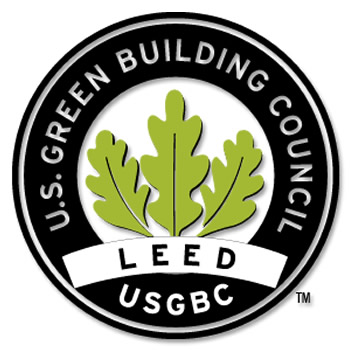How HydroPoint Can Help You Achieve LEED Certification
What is LEED?
Leadership in Energy and Environmental Design, more commonly known as LEED, is an internationally recognized green building certification system. The system provides independent verification that a building or community was designed and built using strategies that improve environmental performance over a building’s lifetime; that is, shows conservation in energy, water, CO2 emissions, indoor environmental quality and stewardship of resources.

Earning LEED Points for Water Efficiency
This brief will focus entirely on the Water Efficiency (WE) portion of LEED.
The goal of WE is to decrease a building’s water demands. Points toward LEED certification are earned based on how well specified criteria are met. Projects can earn points, for instance, for implementing water savings strategies such as designing with drought-tolerant materials, installing weather-based or soil moisture sensor-based irrigation controllers and using non-potable water for irrigation. Building Design & Construction (new construction) and Building Operations & Maintenance (existing building) have slightly different point structures.
Water Efficiency Points for Building Design & Construction
There are three prerequisites to earning WE points:
1. Outdoor Water Use Reduction – 2 Options
a. Eliminating irrigation after a two-year establishment period.
b. Or, reducing water use from the baseline of a site’s peak watering month by at least 50%.
The reduction must first come from plant species selection and irrigation system efficiency as calculated in the EPA WaterSense Water Budget Tool, and only applies to landscape spaces exceeding 1,000 sq. ft. Additional reductions may be achieved using any combination of efficiency, alternative water sources and smart scheduling technologies.
2. Indoor Water Use Reduction – The building’s water fixtures, including toilets, urinals, dishwashers, clothes washers, showerheads and faucets, must use 20% less water than the baseline.
3. Building-level Water Metering – Requires the use of water metering across an entire building to accurately record usage. Sub-metering of irrigation water usage is also encouraged.
There are a total of 11 points available in the Water Efficiency category for new construction.
- WE Credit 1: Outdoor Water Use Reduction Up to 2 points
- WE Credit 2: Indoor Water Use Reduction Up to 6 points
- WE Credit 3: Cooling Tower Water Use Up to 2 points
- WE Credit 4: Water Metering 1 point
Water Efficiency Points for Building Operations & Maintenance
There are two prerequisites to earning WE points, although they apply only to indoor water use and metering; there are no prerequisites for outdoor water use reduction. This brief will not cover those prerequisites.
There are a total of 13 points available in the Water Efficiency category for existing buildings.
- WE Credit 1: Outdoor Water Use Reduction Up to 2 points
- WE Credit 2: Indoor Water Use Reduction Up to 5 points
- WE Credit 3: Cooling Tower Water Use Up to 4 points
- WE Credit 4: Water Metering Up to 2 points
How HydroPoint Can Help You Reduce Outdoor Water Use
HydroPoint’s weather-based controllers (WeatherTRAK branded) and soil moisture sensors and irrigation controllers Baseline can help you meet water reduction goals and qualify for points under the Water Efficiency category.
Irrigation controllers save water that’s being wasted. You’ll need to first determine your baseline water usage during the month of July, considered the peak watering month. If you don’t have a water meter installed, use the WaterSense Water Budget Tool to calculate a baseline. Conducting the analysis can lead to the use of alternative sources of water for irrigation such as from a cooling tower, thus helping to reduce the amount of potable water needed.
Based on over 20 multi-year, independent studies, HydroPoint WeatherTRAK users experience, on average, 35% water savings. Controller Efficiency (CE), an important component of LEED Outdoor Water Use Reduction, is the percent reduction in water use and is calculated by deducting a device’s water savings from 1. The CE for HydroPoint WeatherTRAK ET series controllers is 0.65. You’ll need to insert 0.65 into LEED irrigation design case calculations where you see CE. (Information on Baseline’s CE may be found here.)
When you apply the correct amount of water, you’ll see healthier plants and, through the promotion of deeper, healthier root systems, improved water efficiency. In addition, by properly programming your irrigation controller, you should meet or exceed LEED requirements for Outdoor Water Use Reduction. Although not covered in this document, HydroPoint flow monitoring solutions enable you to precisely measure your water usage. As an added bonus, you’ll receive alerts and notifications of anomalous use so you can address problems and catch issues before they turn catastrophic.
More information about the U.S. Green Building Council’s LEED program may be found at www.usgbc.org/LEED.
WeatherTRAK converts 95% of water conservation potential, meeting plant water budget. — Los Angeles Department of Water and PowerWeatherTRAK reduces outdoor water use by up to 59%.
Santa Barbara County Water Agency

